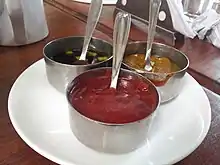Black vinegar
Black vinegar is dark-colored vinegar used in Chinese cuisine.

Types
China
One of the most important types of Chinese "black vinegar" is the Shanxi mature vinegar (simplified Chinese: 山西老陈醋; traditional Chinese: 山西老陳醋; pinyin: lǎo chéncù) from the central plains of Northern China, particularly in the Shanxi province (Shanxi mature vinegar).[1] It is made from sorghum, peas, barley, bran and chaff and has a much stronger smoky flavor than rice-based black vinegar. It is popular in the north of China as a dipping sauce, particularly for dumplings.
Another type of Chinese "black vinegar" is Zhenjiang vinegar (simplified Chinese: 镇江香醋; traditional Chinese: 鎭江香醋; pinyin: zhènjiāng xiāngcù) and similar condiments from southern China.[2] The condiment is an inky-black rice vinegar aged for a malty, woody, and smoky flavor.[3][4] It is made from rice (usually glutinous),[5] or sorghum, or in some combination of those, sometimes including wheat and millet.[6] Black vinegar was traditionally aged in clay pots.[7]
In Sichuan black vinegar is made from wheat bran and flavored with traditional medicinal spices. Sichuan's Baoning vinegar (保寧醋 or 保宁醋) is a famous example.
Black vinegar from Fujian is made using glutinous rice and colored red by the infusion of a special fungus.[7]
Japan
The Japanese kurozu, a somewhat lighter form of black vinegar, is made only from brown rice.
Korea
In Korea black vinegar is also made with brown rice.[7]
History
Ancient Chinese laborers used wine as a leavening agent to ferment and brew vinegar. East Asian vinegar originated in China, and there are at least three thousand years of documented history of making vinegar. In ancient China, "vinegar" was called "bitter wine," which also indicates that "vinegar" originated from "wine".[8]
Uses
Black vinegar has been used as a full-flavored but less expensive alternative to traditional balsamic vinegar.[4][5]
See also
References
- "Sour Story - Shanxi Mature Vinegar". CRIENGLISH.com. 2009-03-05. Archived from the original on July 25, 2016. Retrieved 2015-07-17.
- DK Publishing (2010). "Oils, Vinegars, and Flavorings: Vinegars". The Illustrated Cook's Book of Ingredients. New York: DK Publishing. p. 516. ISBN 9780756667306. Retrieved March 21, 2012.
- Helm, Janet (March 29, 2012). "Is Black the New Black in Foods?". WebMD. Archived from the original on August 27, 2012. Retrieved 2012-08-26.
- Kapadia, Jess (August 17, 2012). "Could Black Vinegar Be The New Balsamic?". FoodRepublic.com. Archived from the original on August 21, 2012. Retrieved 2012-08-26.
- Passmore, Jacki (1991). "Black Vinegar". The Encyclopedia of Asian Food and Cooking. Hearst Books via Oregon State University. Archived from the original on 2014-07-14. Retrieved 2012-08-26.
- Switzer, Christine (October 9, 2010). "Health Benefits of Black Vinegar". LiveStrong. Retrieved 2012-08-26.
- Wei, Clarissa. "Black Vinegar Doesn't Just Season a Dish–It Transforms It". www.bonappetit.com. Retrieved 30 May 2021.
- "Throughout history, vinegar is more than tasty". archive.shine.cn. 2016-03-23. Retrieved 2020-06-10.
